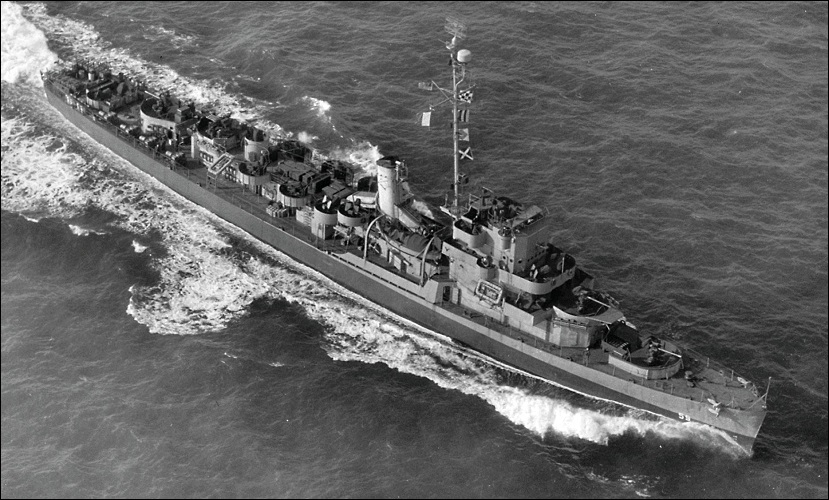The following
abbreviations are used in this article: AA (antiaircraft
gun), AS (antisubmarine) DC (depth charge), DCT (depth
charge thrower) DP (dual purpose surface/antiaircraft gun), TT (torpedo tubes),
HMS (His Majesty's Ship), USS (United
States Ship). RN (Royal Navy), USN (United States Navy). Relevant USN hull type codes were DE
(destroyer escort), ADP (fast transport) and DER (destroyer
escort radar picket). In US Navy parlance, guns of 3in
caliber and larger were described by caliber and barrel
length as a multiple of caliber. Thus the 3in/50 DP gun had
a caliber of 3 inches and a barrel length of 150 inches.
● ● ●
Few
people today appreciate the size and scope of the United
States’ 1941-45 industrial mobilization. President Franklin
Delano Roosevelt dubbed America the “arsenal of democracy”
even before the country entered World War II, and so it was.
Guns, tanks, vehicles of all kinds, warplanes, munitions and
countless other items were produced in quantities that
boggle the mind. It was the greatest wartime industrial
effort put forth by any nation—ever.
Particularly noteworthy were the achievements of the
shipbuilding industry. In many ways the United States Navy
was the most impressive of the Allied fighting services, and
one reason for this was the quality and quantity of the
ships themselves. Twenty-five fleet aircraft carriers (“Essex”
class) and eleven light fleet aircraft carriers (“Independence”
and “Saipan” classes) headed the wartime construction
list—representing the tip of an enormous iceberg. There were
also four “Iowa”-class
battleships, numerous cruisers and fleet destroyers and
countless smaller warships, among them 507 destroyer escorts
(DE)—the latter all constructed between 1942 and 1945. An
additional 50 DEs were completed as fast transports (ADP;
see below).
The DE
program originated with a British request. Early in the war
the Royal Navy had identified a requirement for a warship
intermediate in size and capability between small escorts
such as corvettes and frigates, and fleet destroyers. The
result was the Hunt class, built in four series.
These ships had the same general layout as full-size
destroyers but were smaller, with less firepower. The
“Hunts” proved to be highly effective in their designed role
as antisubmarine/antiaircraft escorts and the RN wanted many
more of them. But since the British shipbuilding industry
was already stretched to the limit, only the United States
could provide such ships.
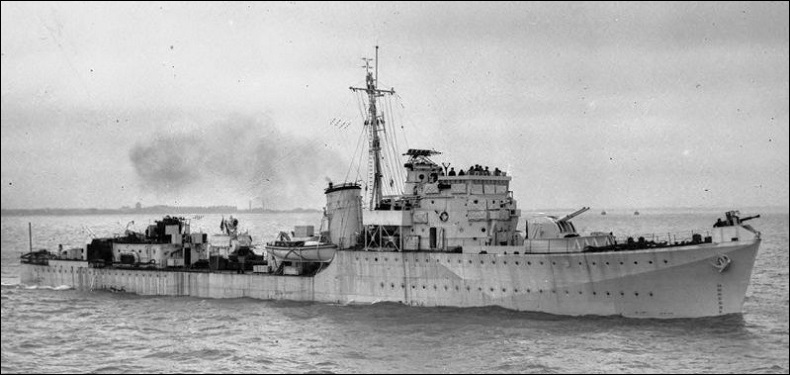
HMS Fernie (L11),
a Type I "Hunt"-class escort destroyer. The RN's need
for such ships was the genesis of the US destroyer escort
program (Imperial War Museum)
In fact
the destroyer escort concept had been considered and
rejected by the US Navy, prewar studies concluding that
full-sized fleet destroyers, already in full production,
could better meet the USN’s escort requirements. But in June
1941 the British Supply Council in North America asked if
destroyer escorts could be provided for the RN out of US
resources; a long-term program of 100 units was suggested. A
50-ship program received presidential approval in August,
and the type was designated British Destroyer Escort (BDE).
From these modest beginnings evolved the vast DE
construction program.
The
1942-45 DEs were divided into six classes, but these were
really variations of the same basic design, exemplified by
the characteristics of the initial “Evarts”
class—also known as the GMT class—of which 97 were
constructed. These ships had a standard displacement of
1,192 tons, were 283 feet long with a beam of 35 feet, and
were powered by two General Motors diesel engines (hence the
GMT or General Motors Tandem designation) giving a top speed
of 20-22 knots. This was some 15 knots slower than a fleet
destroyer but adequate for escort work. Average convoy
speeds were 12-14 knots and most German U-boats could make
no more than 18 knots surfaced and eight knots submerged.
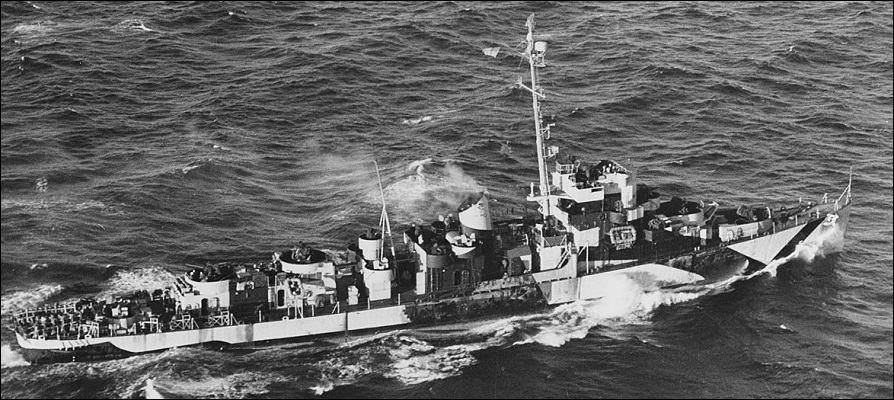
The first of the many: USS
Everts (DE-5), name ship of her class, underway off
Boston, August 1944 (Naval Heritage & History Command)
The GMTs
were were armed with three 3in/50 dual-purpose guns, one
quadruple 1.1in antiaircraft gun, nine single 20mm AA guns,
one Hedgehog AS mortar, eight DCT and two DC racks. Ship’s
complement was 156 officers and men. Later on the light AA
armament was changed to one twin 40mm Bofors and eight 20mm
AA—roughly standard for all DE classes later in the war. The
"Evert" class and later DEs were fitted with the latest
search and attack sonar equipment. It was housed in a
retractable pod that when deployed reduced the DE's sea
speed to 10-12 knots.
All but three of the GMTs
were completed by the end of 1943. Of the class, 65 were
commissioned in the US Navy and 32 went to the Royal Navy as
the “Captain” class.
The RN transfers were not fitted with the quadruple 1.1in AA
gun mount, receiving extra 20mm guns instead.
Next
came the “Buckley”
class, also known as the TE class, reflecting a change from
diesel engines to steam-fired General Electric
turbo-electric propulsion. They were also longer (300 feet)
than the GMTs. Together, the TE power plant and the extra
length gave the Buckley class a better turn of speed
than their predecessors: 23-24 knots. Initially the TEs
carried the same armament as the GMTs, but many of them
later received two 5in/38 DP guns in place of the
3in/50s—the original DE design having incorporated space and
weight reservations to accommodate this heavier armament.
Space and weight had also been reserved for a triple torpedo
tube mount, and many of the TEs eventually received it. With
148 units constructed, the TEs constituted the largest
wartime DE class; 46 went to the Royal Navy. The only other
foreign transfers during the war were fourteen of the
subsequent “Cannon”
(DET) class, of which six went to the Free French Navy and
eight to the Brazilian Navy.
The
following four DE classes were similar to the TEs, differing
mainly in the type of power plant. Many of the later ships
were completed with 5in/38 guns and torpedo tubes, though in
1944-45 the tubes were removed from DEs in the Pacific
to make space for extra 40mm AA guns. At one point in 1943
there were no fewer than 1,005 DEs on order—this to ensure
that a minimum of 300 would be delivered by the end of the
year. But 305 were canceled in late 1943, 135 in 1944 and
two after the war in 1946.
The DEs
were designed for prefabricated construction. Components
were manufactured all over the United States for delivery to
shipyards were final assembly took place. Though it took six
months to construct the first DEs, later on they were being
turned out in six to eight weeks. By way of comparison,
construction of the USS Gearing, name ship of the
USN’s final wartime fleet destroyer class, took ten months
from laying down to commissioning.
In the
Atlantic, the Mediterranean and the Pacific, the DEs with
their modern sonar and heavy antisubmarine armament were
successfully employed as convoy and amphibious force
escorts. Particularly notable was their service in the
latter theater. For the campaign being waged against Japan,
the US Navy evolved the task force concept: in land warfare
parlance, a combined arms organization. Task forces
embodying the most modern ships—variously aircraft carriers,
battleships, cruisers, fleet destroyers—provided distant
cover for landing operations by acting on the offensive
against enemy naval forces. The actual landings were
conducted by task forces including attack transports, cargo
ships, specialized amphibious warfare vessels, etc., with
direct gunfire and air support provided by task forces
formed with older battleships, cruisers and destroyers and
the small escort aircraft carriers. DEs were the primary
escorts for such task forces.
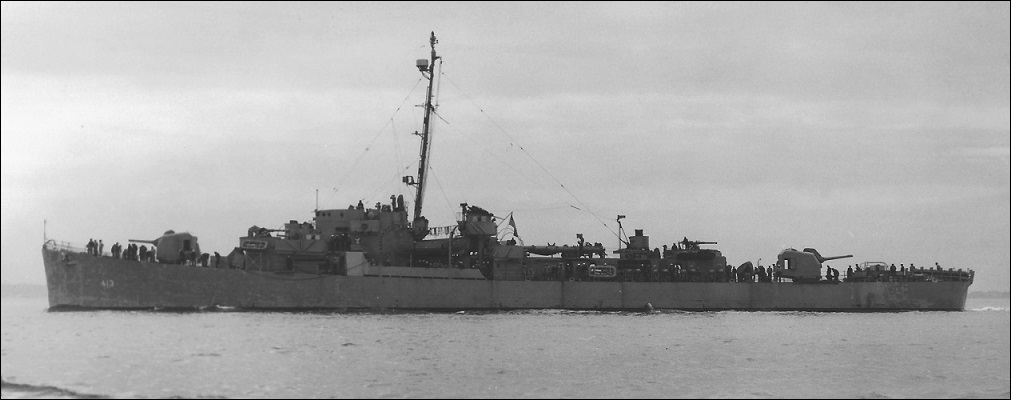
USS Samuel B. Roberts,
(DE-413), hero ship of the Battle off Samar (US National
Archives)
At the
Battle off Samar (25 October 1944) the three
“Fletcher”-class fleet destroyers and four DEs of Task Unit
77.4.3 (Taffy 3), an escort carrier group, fought a valiant
action against a greatly superior Japanese force that was
attempting to close with and destroy the Leyte invasion
force. Attacking
with guns and torpedoes, the “little boys” of Taffy 3 staved off
disaster by preventing the Japanese from reaching the highly
US vulnerable invasion fleet. Among the US ships
lost was USS Samuel B. Roberts (DE-413) of the “John
C. Butler class,” sunk in action against a Japanese heavy
cruiser three times her size—which she severely damaged with
gunfire and torpedoes at point-blank range before being
sunk herself.
During
the war, no fewer than 94 DEs were modified to serve as
high-speed light transports (APD), reinforcing the
prewar
flush-deck APD conversions in the Pacific theater. Of the
“Buckley” class, 43 were modified after completion as
DEs; of the “Rudderow”
class 50 were modified while under construction and one
after completion as a DE. The conversion included an
enlarged superstructure to accommodate troops, with davits
added to handle four small landing craft (LCVP). Gun
armament was altered to one 5in/38 forward plus three twin
40mm Bofors and six single 20mm AA. The APDs carried no
Hedgehog but they did retain DC racks and throwers.
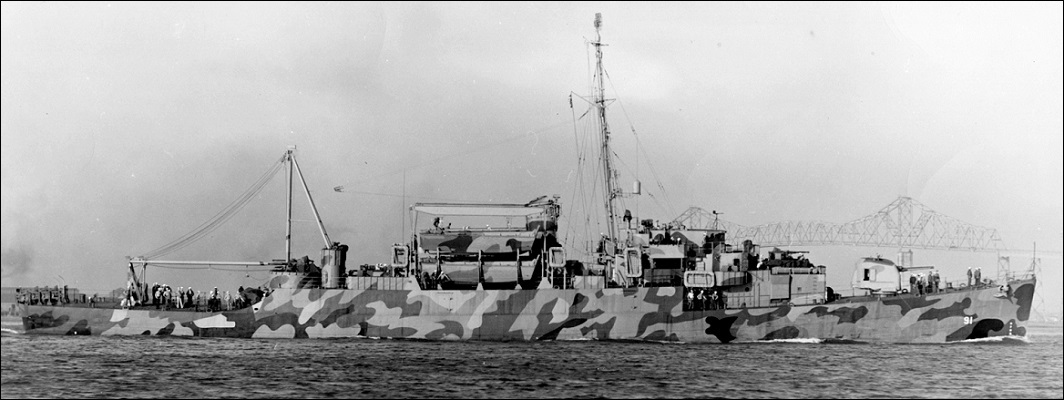
High-speed light transport USS Kinzer
(APD-91) in 1945. Launched as a "Rudderow"-class DE, she was
completed as an APD.
(Naval Heritage & History Command)
Like
their flush-deck predecessors, the DE APD conversions proved
extremely useful in the Pacific and saw arduous service:
transporting raiding parties and underwater demolition
teams, running supplies, escorting convoys and conducting
antisubmarine patrols. A few DEs of the “Buckley” class were
modified to serve as radar pickets (DER), armament being
reduced to make room for long-range radar equipment. Though not very
successful this modification foreshadowed the more
extensive DER conversions of the Cold War era.
The DEs
transferred to Britain as the “Captain” class received only
minor modifications in RN service. Most served in the
Atlantic as antisubmarine escorts, but some were allocated
to Coastal Forces as flotilla flagships. These ships were
fitted with additional light weapons, most prominently a
2-pounder (40mm) pom-pom in the bow against German E-boats.
Three other “Captains” were modified to serve as amphibious
command ships for the Normandy invasion. They lost all their
antisubmarine armament and the aft 3in/50 gun, and had
deckhouses added to accommodate command staff and
additional communications equipment. At the end of the war,
all of the “Captains” were returned to the US.
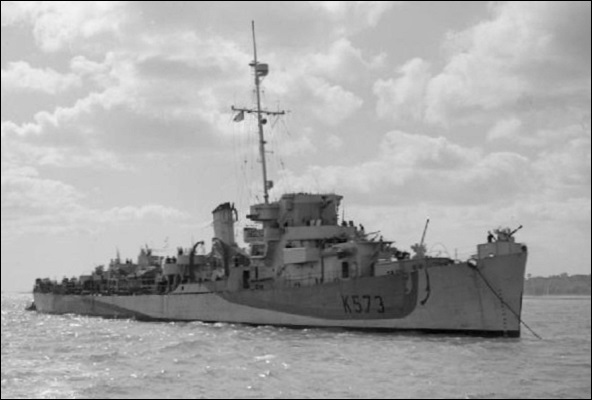
HMS Stayner (K573),
a "Captain"-class frigate serving as a Coastal Forces
flotilla leader. Note the 2-pounder (40mm) pom-pom in the
bow. (Imperial War Museum)
With the end of the war almost all DEs were quickly decommissioned. Most of
the “Everts” class were struck from the Navy List and
scrapped in 1946-47. The ships of the “Buckley” class went
into the Reserve Fleet, where they remained until being
stricken and scrapped from the mid-Sixties to the
mid-Seventies. Of the “Canon” class, large numbers were
transferred to friendly foreign navies, e.g. six to the
Royal Netherlands Navy in 1951-52 as the “Van Amstel” class.
Other DEs were transferred on loan to the US Coast Guard
(1951-54), and many were recommissioned for service during
the Korean War. They also proved useful as training ships
for the Naval Reserve and at least a dozen were so employed.
Finally, a number of DEs were reconstructed to serve as
radar picket ships (DER) in support of carrier task forces.
Thirty DEs were so converted and the last of them did not
leave active service until the mid-1970s.
The very
last DE in service was the Phillippine Navy’s BRP Rajah
Humabon (PS-11), the former USS Atherton (DE-169)
of the “Canon” class. After service in World War II she was
decommissioned and placed in the Reserve Fleet until 1955,
when she was transferred on loan to the Japanese Maritime
Self-Defense force along with a sister ship. As Hatsuhi
(DE-263) she served for twenty years, being returned to the
US in 1975. In 1978 she was refitted and transferred to the Philippine
Navy, with which she was destined to serve for forty years.
At the time of her final decommissioning in 2018, Rajah
Humabon was classified as a patrol ship, with all
antisubmarine weapons removed. Otherwise, however, the old
veteran looked much the same as she had during her wartime
service with the US Navy.
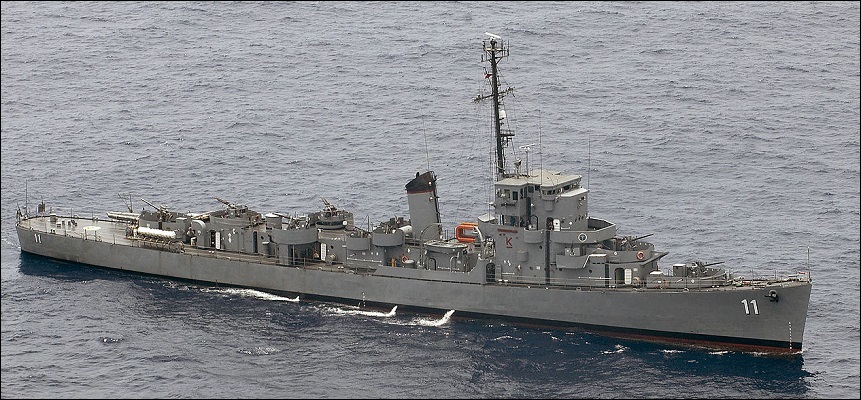
The last of the many: BRP
Rajah
Humabon (PS-11) in 2009 (Philippine Navy)
